Chapter 15 Plant Growth and Development
Class 11th Biology Important Questions
Class 11 Biology Chapter 15 Important Extra Questions Plant Growth and Development
Plant Growth and Development Important Extra Questions Very Short Answer Type
Question 1.
In which phase of the growth curve the growth is maximum?
Answer:
Exponential phase
Question 2.
Write the full form of IAA?
Answer:
Indole acetic
acid
Question 3.
Which plant hormone controls the process of apical
dominance?
Answer:
Auxin
Question 4.
Which hormone acts as a “stress hormone”?
Answer:
Abscisic acid (ABA)
Question 5.
Name the only gaseous natural plant growth regulator.
Answer:
Ethylene.
Question 6.
What are photo plastic seeds?
Answer:
Photo plastic
seeds require light for germination.
Question 7.
What is the exponential period of growth?
Answer:
It is
the second phase of maximum growth.
Question 8.
What is vernalization?
Answer:
Vernalization is a
promoter of flowering by previous cold treatment.
Question 9.
What is senescence?
Answer:
It is the period between
reproductive maturity and the death of a plant.
Question 10.
What will happen if short-day plants are exposed in day
lengths in excess of their certain critical photoperiod?
Answer:
These
will remain only vegetative.
Question 11.
Name the three stages of cellular growth
Answer:
- Cell division
- Cell enlargement
- Cell maturation
Question 12.
Name the plant hormones concerned with the following:
(i)
Elongation of cell
Answer:
Auxins
(ii) Shedding of leaves
Answer:
Abscisic acid
(iii) Breaking of seed dormancy
Answer:
Gibberellins
Question 13.
List four growth regulators of plants
Answer:
- Auxins
- Gibberellins
- Cytokinins
- Abscisic acid
Question 14.
Mention two functions of auxins
Answer:
- Promote cell elongation
- Bring about rooting on stem cutting
Question 15.
Does far-red light help in growth?
Answer:
Far-red
light brings about flowering in short-day plants.
Question 16.
Name the chemical which carries stimulus for flowering from
leaves.
Answer:
Florigen
Question 17.
Where is auxin synthesized in the plants
Answer:
Meristems, enlarging tissues and young leaves.
Question 18.
Which hormone can be used to prevent abscission?
Answer:
Auxin (growth hormone)
Question 19.
Define photoperiodism.
Answer:
The response of plants
in terms of flowering to the relative length of day and night is called
photoperiodism.
Question 20.
Define development.
Answer:
When the cells change their
shapes and take up specialized functions, it is called development.
Plant Growth and Development Important Extra Questions Short Answer Type
Question 1.
Draw a diagram to show the sigmoid growth curve and write the
names of the three phases in it.
Answer:
The rate of growth whether
measured as length, area, volume or weight is not uniform. Under ideal
conditions when the rate of growth is plotted against time, an S-shaped curve
called the sigmoid curve.
- Lag-phase: Growth is slow in the initial stage.
- Exponential period: It is the second period of maximum growth.
- Stationary phase: When the nutrients become limiting growth slows down.
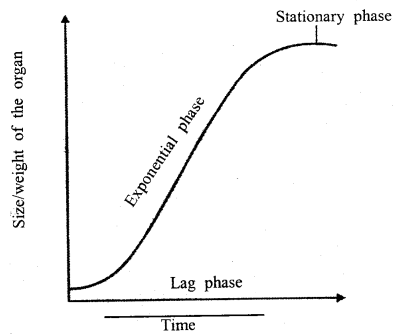
S-shaped or sigmoid population growth
curve characteristic of many species when introduced into a variable new
environment.
Question 2.
What is vernalization? Give its importance in flowering
plants.
Answer:
The term vernalizations are the promotor of flowering by
previous cold treatment. In flowering plants, plants that require cold treatment
usually behave as biennials. They germinate and grow vegetatively in the first
season and produce flowers in the second season. It is now definitely known that
by various grafting experiments the growing point is the site that receives the
cold stimulus. It is responsible for the productions of a hormone-like substance
called remain.
The effect of vernalization can be removed if plants are again treated with high temperatures.
Question 3.
Explain the biological meaning of growth. In what essential
ways does plant growth differ from animal growth?
Answer:
Growth is the
sum total of various processes that combine to cause an irreversible increase in
mass, weight, or volume. The growth is invariably accompanied by
differentiation, which is explained by quantitative changes in terms of the
structure and functions of the cell. Plant growth differs from animal growth in
its unlimited and undefined pattern of growth.
Question 4.
Explain how the method of science operated in the discovery of
auxins?
Answer:
The discovery of auxin was the result of an investigation
by Darwin (1880) while studying the bending of the coleoptile of phalaris sp
(grass) towards the light. He established that the tip of coleoptiles was able
to perceive the light stimulus.
The light stimulus was transmitted to the sub-apical region where differential growth caused bending. A hypothesis was formulated that there is a transmitter. Boysen-Jensen (1913) demonstrated experimentally. In (1928) it was finally proved the existence of a chemical transmitter and called the substance Auxin.
Question 5.
Discuss the role of growth regulators in agriculture.
Answer:
Growth regulators play important role in agriculture:
- Dorminy of seed is broken within a few time
- The miniature of the plait body is improved.
- Time of germination becomes less.
- Some plant growth regulators are IBA, IAA
- Initiation and promotion of cell division are very useful in tissue culture by growth regulators.
Question 6.
Explain Bolting.
Answer:
Just prior to the reproductive
phase in ‘rosette’ plants like cabbage, the internodes elongate enormously
causing a marked increase in stem height. This is called Bolting. In natural
conditions, bolting requires either long days or cold nights.
Question 7.
Write the functions of Auxin (IAA).
Answer:
- Auxin promotes elongation and growth of stems and roots and the enlargement of fruits by stimulating cell walls to stretch in more than one direction.
- Auxin promotes cell division in vascular cambium.
- Auxin promotes root initiation.
- It causes the development of callus in tissue cultures.
- Auxin is also involved in apical dominance and abscission.
Question 8.
What part of the plant perceives the light response?
Answer:
It has been demonstrated that a plant from which all leaves have been
removed fails to flower even under the inductive light regime. This has been
confirmed from experiments with Xanthium, a short-day plant. Even if one eight
of a leaf was exposed to short days, flowering occurred. Even a single leaf
exposed to a short day was able to induce flowering when it was grafted onto a
plant kept under non-inductive conditions.
Question 9.
Distinguish between phototropism and photoperiodism.
Answer:
| Phototropism | Photoperiodism |
| (i) Phototropism is tropic movement in response to light. | (i) Photoperiodism is a physiological response to the changes in relative lengths of day and night. |
| (ii) It is caused by the differential growth in the elongation zone. | (ii) It is caused by the replacement of vegetative bud into reproductive bud |
Question 10.
Distinguish between Long day plants and Short-day plants.
Answer:
| Long day plants | Short day plants |
| (i) These plants begin flowering when the day length exceeds a critical length | (i) These plants begin flowering when the day length is shorter than a critical length. |
| (ii) Light period is critical for flowering, i.e., they require darkness below the critical period. hence called short-night plants. | (ii) Long continuous and uninterrupted dark period is critical for flowering, i.e., they require darkness above a critical Level hence called long-night plants. |
| (iii) Supply of gibberellins does not induce flowering under non-inductive photoperiods | (iii) Supply of gibberellins induces flowering under non-inductive photoperiods. |
Question 11.
What do you understand by photoperiodism and vernalization?
Describe their significance.
Answer:
Some plants require the exposure of
light for a longer period and some requirements for a shorter period than the
critical period for flowering.
The plants requiring a longer exposure to light in than critical period are called long-day plants, whereas those requiring light for a shorter period are called short-day plants and the remaining come under the class or neutral or intermediate day plants.
The ability of the plant to detect and respond to the length of the daily period of light or more precisely, the relative length of day and night to which the plant is exposed, is called photoperiodism.
Significance: Photoperiodism plays a decisive role in the flowering process.
Vernalization: The method of inducing early flowering by pretreatment of seeds with a certain low temperature is known as vernalization.
The effect of temperature on the growth of plants, especially for flowering. The plants from the temperate regions require a period of low temperature before flowering takes place.
Significance: Significance of temperature between 1 – 10° C to certain varieties of wheat, rice, millets, and cotton accelerates the growth of seedlings and results in early flowering.
Question 12.
Write an essay on growth regulators in plants.
Answer:
The analysis or growth curves provide evidence of physiological control on
growth. Plants produce some specific chemical substances, which are capable of
moving from one organ to the other so as to produce their effect on growth.
These substances which are active in very small amounts are called plant
hormones. They are organic compounds and are capable of influencing
physiological activities leading to promotion, inhibition, and modification of
growth.
The growth regulatory substances are grouped under five major classes, namely auxins, gibberellins, cytokinins, ethylene, and abscisic acid. The other related growth regulators are jasmonic acid, salicylic acid, and brassinosteroids. Some vitamins also regulate the growth of plants.
Organic substances, other than nutrients, which in low concentration regulate growth, development, and differentiation, are termed, growth regulators. These may either promote or inhibit growth. The growth regulators synthesized are not produced naturally within the plants.
Growth hormones or phytohormones are organic substances, which are synthesized in one part of the plant and transported to another part where these affect a specific physiological process to regulate growth. Growth hormones play a very important role in the growth and development of animals.
Question 13.
How will you measure the rate of growth? Describe an
instrument used to measure the increase in height of an angiosperm plant.
Answer:
The growth in length can easily be measured with the help of an
ordinary measuring scale at an interval of time. For precise measurement, the
equipment named auxanometer or autograph can be used. An auxanometer is used to
measure the rate of growth of a plant in terms of shoot length.
A thread is tied to the growing tip of a potted plant and at the other end,
weight is tied after passing the thread over a pulley. The needle attached in
the center of the pulley will show the deflection, which can be read on the
graduated arc to find out the increase in length of the plant.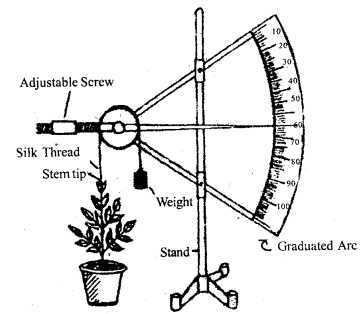
Measurement of growth by Arc-Aux. nanometer
The growth can also be measured by an increase in weight, both fresh and dry volume of the plant. The increase in the number of cells especially in algae, yeast, and bacteria also gives an idea about the rate of growth.
The measurement of the area of the volume of an organ of the plant will also provide information about the rate of growth.
Question 14.
“Growth is an important phenomenon of living.” Justify this
statement with reasons.
Answer:
Growth is one of the most important
phenomena of all living organisms. Growth in plants occurs by cell division and
cell enlargement, invariably followed by cell differentiation. It is the result
of coordination of biophysical increase in size, weight, and volume of an
organism or its part. In plants, it is associated with both anabolic and
catabolic activities, involve an increase in size.
Thus, growth is a quantitative phenomenon and can be measured in relation to time. Growth in living organisms is intrinsic and differs from extrinsic growth in non-living objects. Plants also show movement due to growth. Hence growth is an important phenomenon in living organisms.
Question 15.
What are the important characteristics of growth? Describe in
brief.
Answer:
Growth in plants occurs by cell division and cell
differentiation. The cell division generally occurs in apical regions of shoot
and root. The meristematic cells present at shoot and root apices are
responsible for growth in plants. These cells are also present in vascular
bundles of roots and stems of dicot plants. They help in increasing the
thickness of stem and root due to secondary growth.
The rate of plant growth is slow in the initial stages and increases rapidly later op. The growth slows down due to the limitation of nutrients. The rate of growth is also called the efficiency index.
Question 16.
What are the different phases of growth? Explain with the
help of well-labeled diagrams.
Answer:
Growth in plants is localized in
the meristematic region only, i.e., apical, lateral and even, intercalary
regions. The growth in length is due to the enlargement and elongation of cells
at the apical regions and in thickness due to the activity of lateral and
intercalary meristems.
The period of growth is generally divided into three phases, namely, formative, elongation, and maturation.
The formative phase: This phase has constantly dividing cells and restricted
to the apical meristem both at the root and shoot tips. The cells of this region
are rich in protoplasm with a large nucleus and thin cellulose wall.
Growth regions in a root by parallel line
(Different phases of growth)
The phase of elongation: It lies just behind the formative phase and is aimed at the enlargement of cells.
The phase of maturation: Is further behind and here the cells start maturing to obtain a permanent size. These phases are also known as regions. The time interval from the formative phase to the maturation phase is called the grand period of growth.
Plant Growth and Development Important Extra Questions Long Answer Type
Question 1.
What do you understand by senescence? What are the various
types of senescence observed in plants? Can growth regulators restart
senescence?
Answer:
1. Senescence: Senescence may be defined as the period
between reproductive maturity and death of a plant or a plant part. Senescence
is accompanied by a reduction in functional capacity and an increase in cellular
breakdown and metabolic failures. This process ultimately leads to the complete
loss of organisms or plant parts.
2. Types of senescence: In plants, it is of four types:
1. Whole plant
senescence: It occurs in plants in which the whole plant dies after seed
production e.g., wheat, gram, etc. These plants are annuals and die after seed
production. This phenomenon also occurs in some monocarpic plants, which live
for several years but flower once. For example, certain bamboos and sago
palms.
2. Sequential senescence: In some perennial plants, the tips of the main
shoot and branches remain in the meristematic stage. They continue to produce
new buds and leaves. The older leaves and lateral organs senescence and die.
This type of senescence is called sequential senescence. Example: Mango and
Eucalyptus.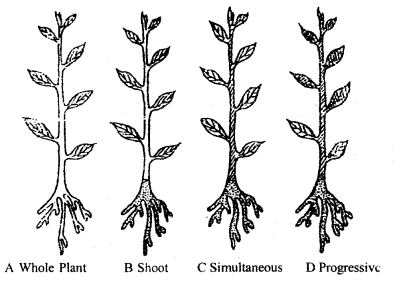
Types of plant senescence
3. Shoot senescence: In certain perennial plants, the aerial shoot dies each year after flowering and fruiting. But the underground modified stem and roots survive under unfavorable conditions. These parts give rise to new shoots again next year under favorable conditions. Example: Banana and gladiolus.
4. Simultaneous or synchronous senescence: This occurs in temperate deciduous trees which shed their leaves annually in autumn. Example: Maple and elm.
5. Reduction of senescence: Cytokinins, the growth regulators retard senescence. They prevent the breakdown of proteins and other biomolecules. Instead, they stimulate the rate of synthesis of proteins and their mobilization. Auxins also retard senescence.
Question 2.
Mention any two causes of seed dormancy. Give its
significance.
Answer:
Many seeds fail to germinate even when they are
provided with favorable conditions. This phase when the seed remains in action
is called seed dormancy. This natural barrier for development is gradually
overcome with time. Sometimes this dormancy is due to the conditions in the seed
itself then it is known as innate dormancy.
It may be due to the following reasons:
- Impermeability of seed coat: In some plants, the embryo is undifferentiated and unorganized when the seed is shed. It takes time to attain full development before it germinates.
- Due to immature embryo: In some plants, the embryo is un-differentiated and unorganized when the seed is shed. It takes time to attain full development before it germinates.
Significance of seed dormancy:
- It enables the seed to be disseminated in time and space.
- It helps them to germinate when environmental conditions are more favorable.
Advantages of reproduction by seed:
- The plant is independent of water for sexual reproduction and therefore, better adapted for a land environment.
- The seed protects the embryo.
- The seed contains food for the embryo (either or cotyledons or in the endosperm).
- The seed is usually adapted for dispersal.
- The seed can remain dormant and survive adverse conditions.
- The seed is physiologically sensitive to favorable conditions and sometimes must undergo a period of after-ripening so that it will not germinate immediately.
- The seed is a product of sexual reproduction and, therefore, has the attendant advantages of genetic variation.
Question 3.
What is the difference between:
(a) Nastic and tropic
movements.
Answer:
Difference between Nastic and tropic movements:
| Tronic Movements | Nastic Movements |
| (1) These are paratonic directional movements of curvature. | (1) These are paratonic non-directional movements of curvature. |
| (2) These are growth movements caused due to differential growth only. | (2) These are either growth or turgor movements, caused due to differential growth or changes in turgor. |
| (3) These occur in radically symmetrical organs like root and stem. | (3) These occur in either symmetric organs or those having bilateral symmetry. |
(b) Phototropism and geotropism.
Answer:
Difference between
Phototropism and geotropism:
| Phototropism | Geotropism |
| (1) It is the directional movement of curvature caused by light. | (1) It is the unidirectional movement of curvature caused by gravitational pull. |
| (2) The response depends upon the direction of light. | (2) Different organs show different types of geotropic responses. The stem shows a negative geotropic response. |
| (3) The stimulus is perceived by the apical meristem, perception is done by yellowish pigment like carotenoids. | (3) The stimulus of gravitational pull is perceived by the root cap in the root and apex of the stem. |
| (4) It occurs due to differential growth of the organs in the elongation zone. | (4) The geotropic response is caused due to unequal distribution of auxin on two sides of the horizontally growing axis. |
Question 4.
What do you understand by the spontaneous and induced
movements in plants? Illustrate your answer with suitable diagrams.
Answer:
Spontaneous movements: Plastids in cells may show movements in
response to light, the stem of a plant grows upwards against the force of
gravity or bends towards light. Spontaneous movement may be at protoplasm or
organ or even at the whole plant level. The protoplasmic movements, accomplished
by naked protoplasm in unicellular plants, are generally divided into ciliary,
amoeboid, cyclosis, and gliding. Spontaneous movement is
self-controlled.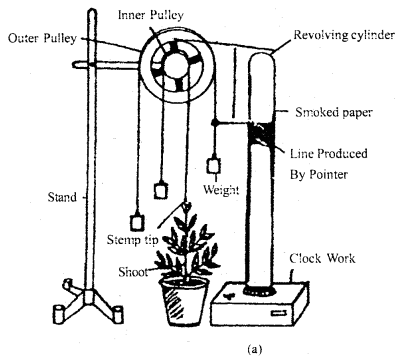
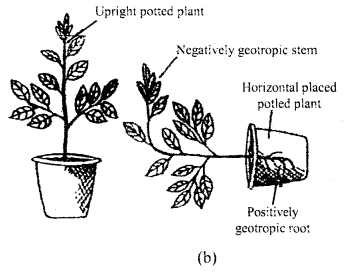
Induced movement: The induced (paratonic)
movement is the movement of a complete cell or organelle and is influenced by
external stimuli. This is also called tactic (taxes or taxis) movement and is
common among lower plants. The movement may be due to chemical substances, such
as sucrose and malic acid, present in archegonium of ferns and moss, which
attract spermatozoids; and mobile bacteria are attached by peptone.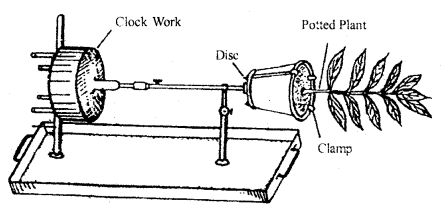
Different types of movement.
Question 5.
Describe the various steps involved in seed germination?
Answer:
Awakening of inactive embryos present inside the seed into a
seedling, capable of independent existence, is termed germination.
Two conditions affect the germination of seed:
(a) External conditions:
External conditions necessary for germi¬nation are water, oxygen, temperature,
and light.
(b) Internal conditions: Sometimes the seeds fail to germinate
even if various external conditions are favorable.
Germination is also controlled by certain internal factors which are discussed as:
- Maturity of the embryo: In certain, plants, the embryo is immature in fully developed seeds.
- After ripening: In certain, plants, even if the embryo is mature but they do not possess the necessary growth hormones. These germinate only when necessary growth hormones are synthesized.
- Dormancy period: Certain seeds remain dormant after their shedding.
- Viability period: The period for which the embryo in seed remains living is termed as viability period. The seeds germinate only within the viability period.
- Reserve food material: The availability of sufficient reserve food material is essential for germination.
- Enzymes and growth hormones: Digestive and respiratory enzymes play an essential role in germination. In the absence of activation of certain enzymes, seeds will not germinate. Hormones like auxins, gibberellins, and cytokinins also play important role in germination.
Seed germination includes all the physical and physiological changes that
occur in the seed.
(a) Absorption of water: The water enters the seed mainly
through the micropyle and imbibed by the reserve food and cell wall material,
resulting in swelling of the seed. It causes the rupture of seed coats, allowing
the radical to grow into the primary root. Aerobic respiration is essential for
seed germination as it makes available the energy needed for the growth of the
embryo.
(b) Mobilization of reserve food materials: The food is stored in the endosperm, or in cotyledons. The various enzymes convent this food into soluble substances, which serve as a respiratory substrate, and the energy released during aerobic respiration is used in various metabolic and physiological changes dining embryo growth. The digested food passed towards the embryo through cotyledon.
(c) Development of embryo into seedling: The embryonic cells become metabolically very active. The radicle starts growing and is first to emerge out through ruptured seed coats. It develops into a root that grows downwards into the soil. The root developing from the radicle is termed as the primary root.
After the development of the primary root from the radicle, either the
epicotyl or the hypocotyl starts elongation, forming dicotyledonous
seeds.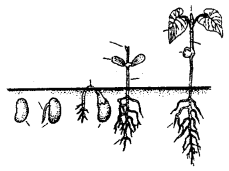
Different stages of germination of seed.